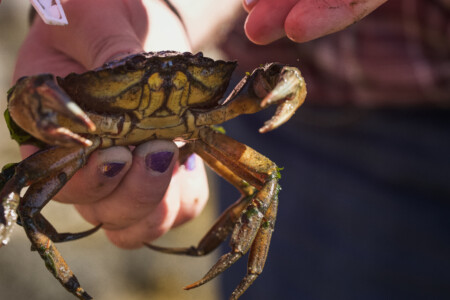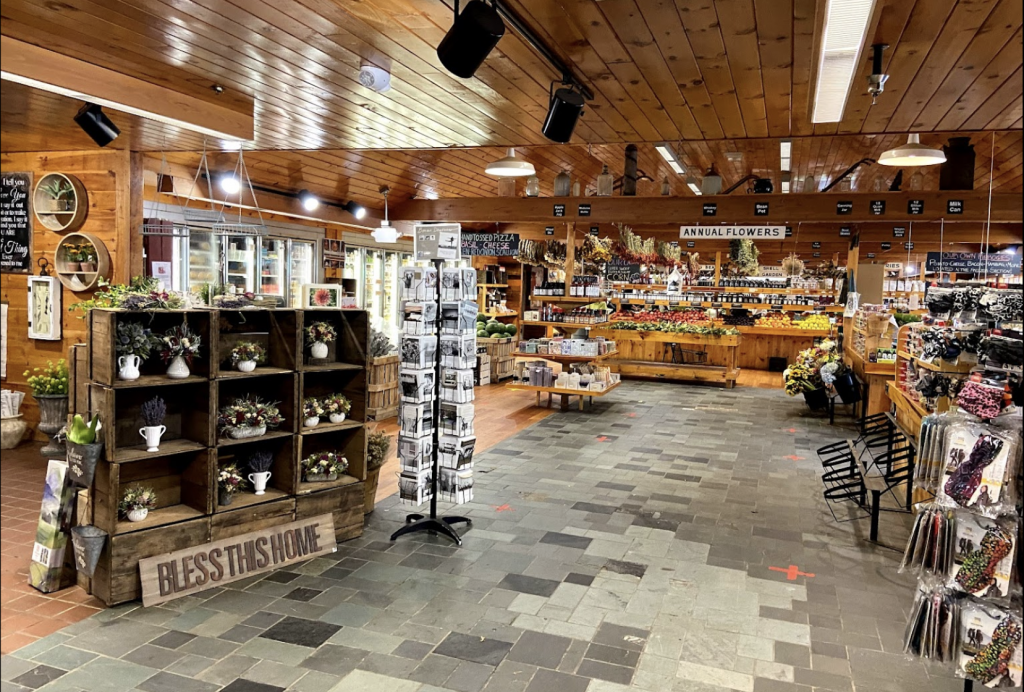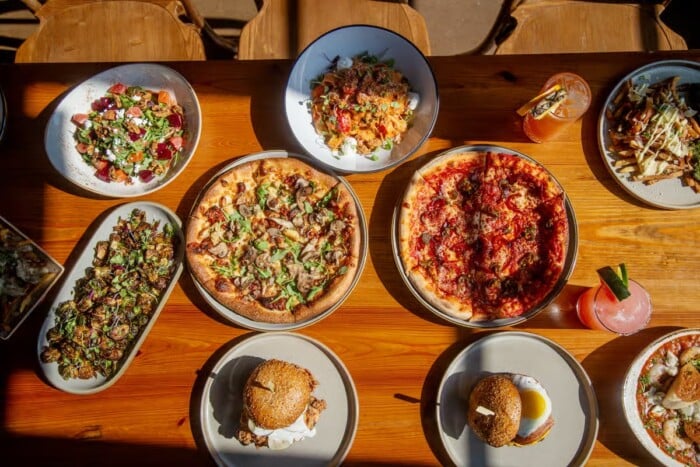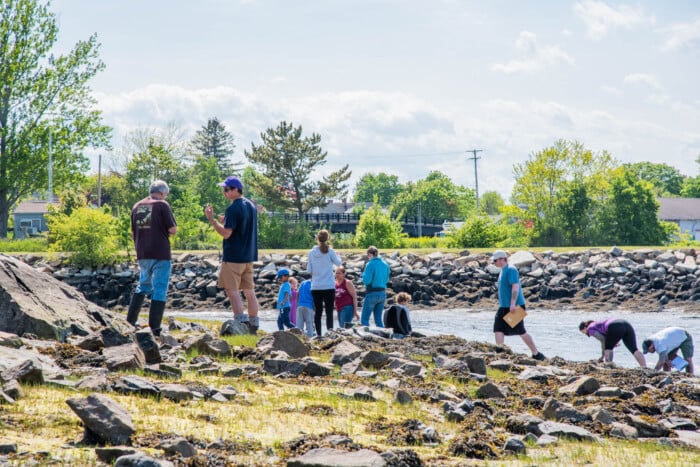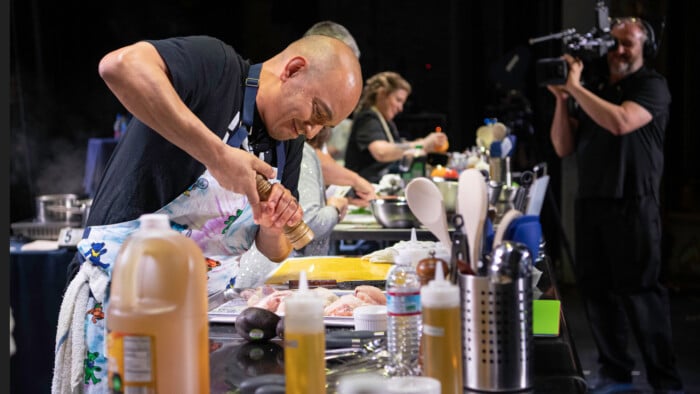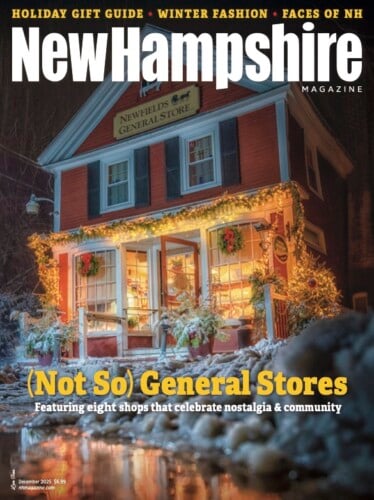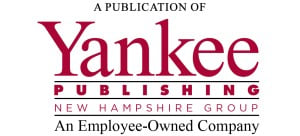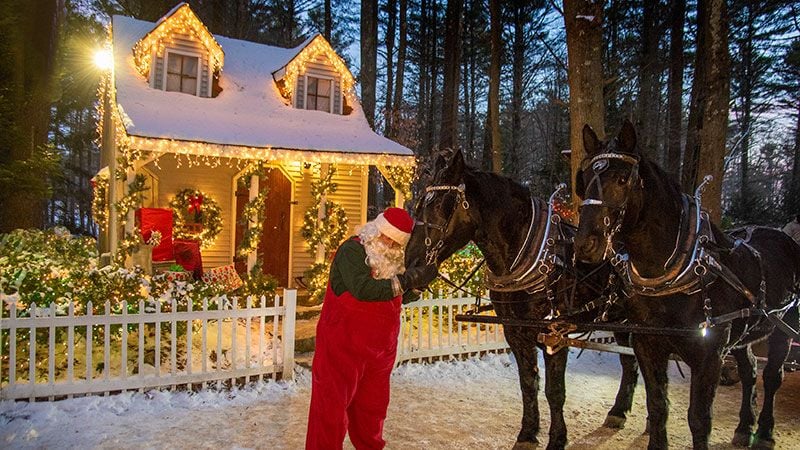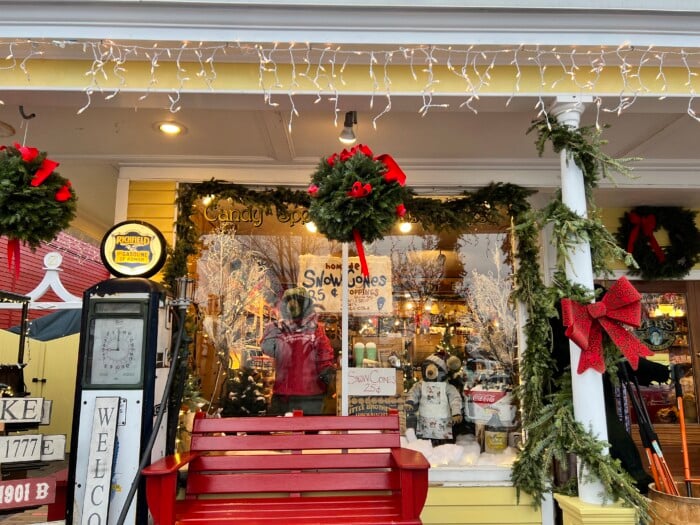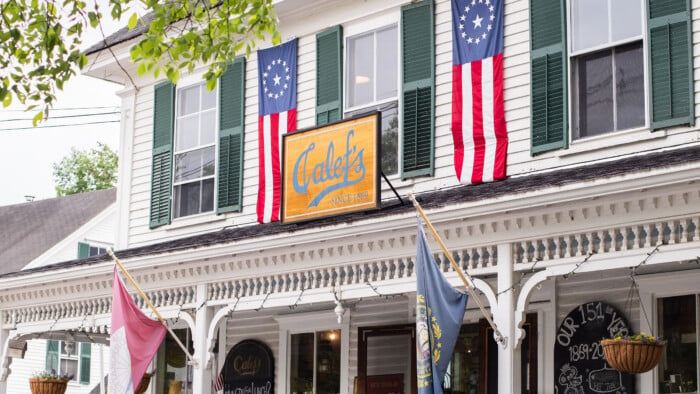Fighting the Green Crab, One Fork at a Time
University of New Hampshire researchers aim to create a green crab market to target the East Coast's green crab invasion
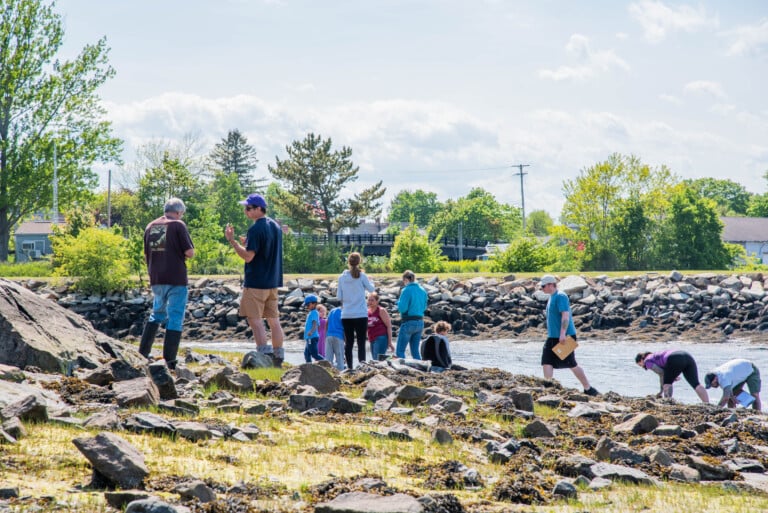
The tide is out this morning at Hilton Park at Dover Point, where the Piscataqua, Squamscott, Bellamy, Oyster and Lamprey rivers meet. It’s also where the invasive European green crab congregates.
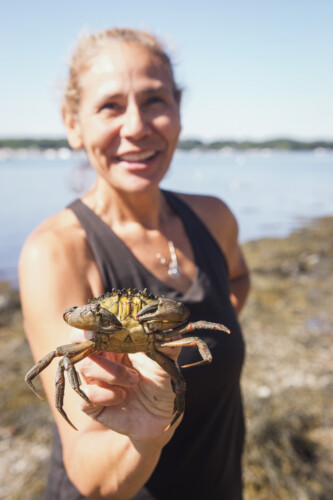
Gabriela Bradt, a Fisheries Extension state specialist with New Hampshire Sea Grant, holds up a European green crab.
A small group has gathered among the wet, sandy rocks and thick piles of bulky algae to find the crabs, which hide underneath heavy seaweed, soft mud and rock crevices to molt. Molting means they’ve outgrown their current shell and shed it for larger environs.
“It’s like they need new clothes,” says Gabriela Bradt, Fisheries Extension state specialist with New Hampshire Sea Grant and UNH Cooperative Extension.
These citizen scientists are taking part in the NH Green Crab Project’s Great Green Crab Hunt, a periodic gathering conducted by New Hampshire Sea Grant along New Hampshire’s shores and salt marshes. Within an hour, volunteers helped researchers document the vitals of each.
Volunteer and UNH student Katri
Gurney of Concord held out her find: one green crab’s well-used former outfit.
“They basically come out of the top. They unfold, they unzipper around here, and they crawl out the back and go hide somewhere else, but they leave all their insides behind,” Bradt says.
Gurney noted how the crab “scooches” out of its old shell.
“I imagine it being like the motion of a squid,” Gurney says, adding that the hunt is relative to her master’s work.
“I’m familiar with watersheds and with engagement in environmental conservation. This was one way for me to get a better understanding of coastal environments,” Gurney says.
Simplifying how green crabs molt is a big part of Bradt’s job. Her work with Sea Grant and UNH Cooperative Extension includes community outreach and education, and the Great Green Crab Hunt combines both.
“Let’s get the public involved in a way that could involve them in science, as well as spreading information about the negative aspects of these crabs,” Bradt says.
The goal is to see whether a soft-shell crab market could exist here. These crabs have little meat, so researchers are seeking alternative ways to consume them.
Katie Geschwendt of Durham and her daughter Jubilee, 9, were trying a green crab hunt for the first time.
“We have not found any crabs,” Jubilee reported, but the two kept looking.
“It’s good experience for adults and young people to try to get connected with the natural world. It’s fun to rifle through seaweed,” Geschwendt says.
This group found 97 green crabs, seven mud crabs and eight Asian shore crabs, another invasive species.
But finding an actively molting European green crab is key to Bradt’s research — it means they’re good for harvesting. Their new shells will be “soft” for about 24 hours, then harden. If collected now and refrigerated, they can later be eaten whole.
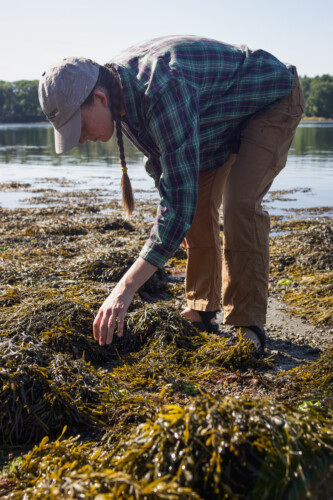
Katri Gurney of Concord, a UNH master’s student and a volunteer for the Great Green Crab Hunt, rummages through heavy piles of seaweed in search of green crabs, which hide under algae and rocks to molt.
Bradt doesn’t mince words.
“At a certain size, they don’t molt as often. Those are the sizes that we were looking for. I call them slider-sandwich size,” Bradt says.
The notorious European green crab has earned a spot on the Global Invasive Species Database’s list of 100 of the world’s worst invasive alien species, taking up residence alongside the cane toad, which competes with native amphibians for food; the zebra mussel, which can smother certain clams; and the Asian gypsy moth, which lays waste to shade, fruit and ornamental trees.
About 200 years ago, the European green crab arrived in southern Maine and New Hampshire from coastal ecosystems around France, Italy and elsewhere, brought by ballast water stored in ships’ cargo holds.
Dr. Jason Goldstein, research director at the Wells National Estuarine Research Reserve, has worked on green crabs since 2016.
“Roughly the mid-Atlantic is where we think green crabs first made landfall, and that over several decades, gradually increased their range north,” Goldstein says.
It has few predators and can outcompete native species, and as food generalists, they eat a lot, including bivalve mollusks, young lobsters, clams, oysters, and mussels.
“These are all very strong attributes to
have if you are an invasive species, because that means you’re going to be able to take advantage of environments like ours,” Goldstein says.
With its ability to live out of water for some amount of time, a knack for withstanding temperature extremes, and its speedy growth and reproduction rates, its numbers spread exponentially, Goldstein says.
“These crabs sort of run around unchecked,” he adds.
And their numbers are staggering. One adult female crab can produce 180,000 eggs, Bradt says. If you think that’s a lot, it is.
“If you have, say, a million crabs, which we absolutely do in New England — let’s just lowball it, right? — So a million females at 180,000, and (if) even 10 percent of those grow up — you do the math, right? It’s astronomical,” says Bradt.
“They are voracious predators,” Goldstein adds.
These champion eaters ruin species’ habitats, contribute to land erosion and wreak havoc on shore vegetation like sea grass beds.
“These shallow underwater meadows of sea grasses are very, very important nursery habitats for small fish and crustaceans,” Goldstein says.
Nathan Furey, a fish ecologist and fish biologist in the Fish and Movement Ecology Lab at UNH, often vacationed with his family along New York’s eastern coast as a youth.
“I spent a lot of time as a kid tidepooling, and certainly caught green crabs pretty regularly. I probably didn’t realize they were invasive until being taught as an undergraduate student,” Furey says.
Now, Furey seeks to alleviate the green crab’s coastal impact.
His research includes tracking green crabs’ movements using a method called acoustic telemetry. Researchers place a tiny electronic tag on a crab (a “backpack,” Furey says), that emits high-frequency pings that tracks their movements.
In 2021, Furey tracked green crabs in the Webhannet estuary in Wells, Maine, and found that once green crabs arrive somewhere, they aren’t performing any large-
scale migrations.
But as the ocean warms, more green crabs are on the way. They’ve recently continued their march around the globe, arriving on the Pacific northwestern coast of the U.S. and Canada.
Bradt first heard about them when local fishermen voiced concerns that the crabs were cutting into their bottom line. So, she spearheaded the New Hampshire Green Crab Project to find answers, eventually collaborating with Furey, Goldstein and other researchers around southern Maine and New Hampshire.
Together, they’re attacking the problem from all angles to put a dent in its impact.
“It kind of became this three-pronged project of outreach, education, monitoring and research, and fishery development,” Bradt says.
The goal was to develop a green crab market or fishery, much like the blue crab, popular along the Atlantic coast, Chesapeake Bay, and Gulf of Mexico. But first, they had to figure out how a green crab fishery could be a viable method for cutting down the crabs’ numbers.
“So we started to look at the feasibility of when they molt. Would people eat them as a soft-shell crab product, like they do for blue crabs down south? Could we mimic some sort of market potential like that,” Bradt says.
This proposed market could provide alternate sources of income or revenue stream for fishers, something that has been in process for several years.
Before COVID, Bradt says, there was ongoing interest in green crabs as a specialty in local restaurants, but the pandemic tamped down those efforts. They’ve been used in pet treats and dog food, and some nonprofits have eyed them for compost, she says. Other uses remain in the research and development phase — as bioactive compounds, in bioplastics using the chitin from their shells, or in aquaculture feeds.
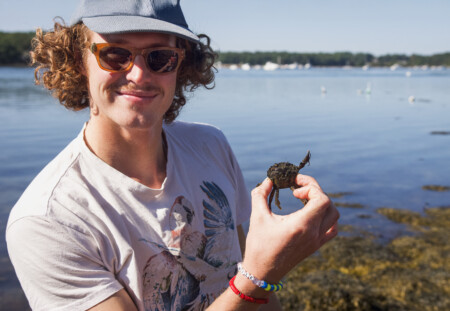
Volunteer Luke Costello of Dover holds up a green crab that he found at Hilton Park in Dover during a recent green crab hunt. Only forage from areas where there are no water quality or red tide warnings. Do not forage at locations with beach closures or other public health warnings.
Mike Masi is a green crab fisherman, oyster farmer, and founder and co-owner of shell+claw in York, Maine. As a marine sciences teacher at York High School, he received grant funds to buy traps and monitor green crabs’ numbers in the York River.
Masi harvests hard-shell green crabs for bait and for culinary markets that can use the crabs for stocks, broths, fermented fish sauce and other southeast Asian dishes.
“They have a rich flavor that is great for stocks/broths, and they are absolutely delicious as soft-shell crab. They are smaller and sweeter than soft-shell blue crab,” Masi says.
They’re simply an underused resource that can diversify “our working waterfront,” he says.
Whether people can turn the tide and bring green crab into the kitchen and elsewhere remains to be seen, but Bradt sees potential when she looks at the blue crab or crawfish markets.
“Whether New Englanders in particular, will eat, it (and say) ‘Yes, I’m going to switch from a clam and a lobster boil to a green crab boil all year long,’ I have high hopes that we’re getting there,” Bradt says.
Changing the narrative around the invasive crab has been a big goal.
“We’ve made great strides. A lot of the verbiage around it had to change. Just because it’s invasive doesn’t mean it’s inedible — it means it’s just not supposed to be here. So eat it up and give something else a chance,” she says.
Broths, chowders and whiskey: green crabs are invading the menu
In Venice, Italy, green crabs are an annual delicacy called “moeche” — could the same thing happen in New Hampshire?
So far, it’s been a long, slow crawl.
Gabriele Bradt, associate fisheries state specialist for New Hampshire Sea Grant and UNH Cooperative Extension, has been promoting the pesky invaders to coastal restaurants and communities for the past decade.
“Thirty or 40 years ago, people had sort of attempted to cook with the green crab, but they didn’t try very hard,” Bradt says. “The fact of the matter is that (green crabs) are small, non-picking meat crabs (difficult to extract meat from). They’re not like a Jonah crab — they’re more reminiscent of a blue crab.”
She’s been looking to the blue crab industry in the South, which could be key to cracking the mystery of the green crab.
“Down South, you wait for the blue crab to molt, and then you eat the whole thing,” Bradt says.
Bradt has connected with restaurants throughout the Seacoast, like Moxie, the Black Trumpet and Botanica, to pool knowledge and resources and present chefs with a culinary challenge: What could they create using green crabs?
A distillery in the Lakes Region used it to create a new whiskey blend. “We collaborated with Tamworth Distilling to create Crab Trapper,” Bradt says. “It’s double-distilled, so it’s just essence of crab.”
Marissa McMahan, director of fisheries at Manomet Conservation Sciences in Plymouth, Mass., boils green crabs as a tasty stock for soup or chowder.
“If I’m feeling more ambitious, I’ll actually pick the meat from the larger green crabs and use it to make crab rolls or crabcakes,” she says. “And of course, when in season, deep-fried soft-shells are hard to beat.”
With so many ways to cook green crab, like boiling, making ceviche, eating the roe or making a broth, professional and non-professional cooks alike can get excited about trying something new.
“The cool thing about green crabs is that you can forage for them on the shoreline,” McMahan says. “So for the adventurous home cook, you can gather your own green crabs and bring them home to experiment with. I also encourage people to check out all the amazing products being developed with green crabs, ranging from dehydrated broth to dog treats to fermented sauces.”
The New Hampshire Sea Grant created a field and kitchen guide that offers tips about how to hunt for soft shell crabs and how to process and eat them.
“This is a good thing to do, because we want our native species to have a fighting chance and it helps repair these ecosystems,” Bradt says. “It’s not a problem we can eat our way out of, but we can make a dent.”
— Elisa Gonzales Verdi
Green Crab Pozole 4 to 6 servings
by Matt Louis, chef/owner Moxy and Franklin Oyster House, Portsmouth
 (Interested in foraging for green crabs? Make sure to only source from areas where there are no water quality or red tide warnings. If there are any beach closures or other public health warnings at the location you want to forage, do not forage there.)
(Interested in foraging for green crabs? Make sure to only source from areas where there are no water quality or red tide warnings. If there are any beach closures or other public health warnings at the location you want to forage, do not forage there.)
Preparation time: 10 minutes
Cooking time: 10 minutes
Ready in: 20 minutes
Ingredients
1 small onion, diced
1 yellow and 1 red bell pepper, diced
4 ounces hominy
1½ quarts green crab stock
½ tablespoon cumin
½ tablespoon smoked paprika
Salt and pepper to taste
½ bushel cilantro
3 red radishes, shaved
4 ounces Napa cabbage, shredded
Instructions
Sweat onions and peppers over medium heat with a little canola oil until soft. Add hominy and spices and toast gently.
Add green crab broth and season to taste.
Split between bowls and garnish with cilantro, radish and cabbage.
